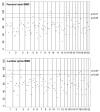Meta-analysis of genome-wide scans provides evidence for sex- and site-specific regulation of bone mass
- PMID: 17228994
- PMCID: PMC4016811
- DOI: 10.1359/jbmr.060806
Meta-analysis of genome-wide scans provides evidence for sex- and site-specific regulation of bone mass
Abstract
Several genome-wide scans have been performed to detect loci that regulate BMD, but these have yielded inconsistent results, with limited replication of linkage peaks in different studies. In an effort to improve statistical power for detection of these loci, we performed a meta-analysis of genome-wide scans in which spine or hip BMD were studied. Evidence was gained to suggest that several chromosomal loci regulate BMD in a site-specific and sex-specific manner.
Introduction: BMD is a heritable trait and an important predictor of osteoporotic fracture risk. Several genome-wide scans have been performed in an attempt to detect loci that regulate BMD, but there has been limited replication of linkage peaks between studies. In an attempt to resolve these inconsistencies, we conducted a collaborative meta-analysis of genome-wide linkage scans in which femoral neck BMD (FN-BMD) or lumbar spine BMD (LS-BMD) had been studied.
Materials and methods: Data were accumulated from nine genome-wide scans involving 11,842 subjects. Data were analyzed separately for LS-BMD and FN-BMD and by sex. For each study, genomic bins of 30 cM were defined and ranked according to the maximum LOD score they contained. While various densitometers were used in different studies, the ranking approach that we used means that the results are not confounded by the fact that different measurement devices were used. Significance for high average rank and heterogeneity was obtained through Monte Carlo testing.
Results: For LS-BMD, the quantitative trait locus (QTL) with greatest significance was on chromosome 1p13.3-q23.3 (p = 0.004), but this exhibited high heterogeneity and the effect was specific for women. Other significant LS-BMD QTLs were on chromosomes 12q24.31-qter, 3p25.3-p22.1, 11p12-q13.3, and 1q32-q42.3, including one on 18p11-q12.3 that had not been detected by individual studies. For FN-BMD, the strongest QTL was on chromosome 9q31.1-q33.3 (p = 0.002). Other significant QTLs were identified on chromosomes 17p12-q21.33, 14q13.1-q24.1, 9q21.32-q31.1, and 5q14.3-q23.2. There was no correlation in average ranks of bins between men and women and the loci that regulated BMD in men and women and at different sites were largely distinct.
Conclusions: This large-scale meta-analysis provided evidence for replication of several QTLs identified in previous studies and also identified a QTL on chromosome 18p11-q12.3, which had not been detected by individual studies. However, despite the large sample size, none of the individual loci identified reached genome-wide significance.
Figures


References
-
- Cummings SR, Melton LJ. Epidemiology and outcomes of osteoporotic fractures. Lancet. 2002;359:1761–1767. - PubMed
-
- Kanis JA. Diagnosis of osteoporosis and assessment of fracture risk. Lancet. 2002;359:1929–1936. - PubMed
-
- Krall EA, Dawson-Hughes B. Heritable and life-style determinants of bone mineral density. J Bone Miner Res. 1993;8:1–9. - PubMed
Publication types
MeSH terms
Grants and funding
- N01-HC-25195/HC/NHLBI NIH HHS/United States
- M01 RR-00750/RR/NCRR NIH HHS/United States
- R01 AR041398/AR/NIAMS NIH HHS/United States
- K01 AR02170-01/AR/NIAMS NIH HHS/United States
- WT_/Wellcome Trust/United Kingdom
- R01 AR45349-01/AR/NIAMS NIH HHS/United States
- R01 GM60402-01 A1/GM/NIGMS NIH HHS/United States
- P01 AG-18397/AG/NIA NIH HHS/United States
- R01 AR043351/AR/NIAMS NIH HHS/United States
- P01 AG018397/AG/NIA NIH HHS/United States
- M01 RR000750/RR/NCRR NIH HHS/United States
- P30 DK072488/DK/NIDDK NIH HHS/United States
- N01 HC025195/HL/NHLBI NIH HHS/United States
- R01 GM060402/GM/NIGMS NIH HHS/United States
- P01 HL045522/HL/NHLBI NIH HHS/United States
- K01 AR002170/AR/NIAMS NIH HHS/United States
- R01-AR050066/AR/NIAMS NIH HHS/United States
- R01 AR43351/AR/NIAMS NIH HHS/United States
- R01 AR050066/AR/NIAMS NIH HHS/United States
- R01-AR/AG 41398/AG/NIA NIH HHS/United States
- P01 HL45522/HL/NHLBI NIH HHS/United States
LinkOut - more resources
Full Text Sources
Other Literature Sources
Medical
Miscellaneous

